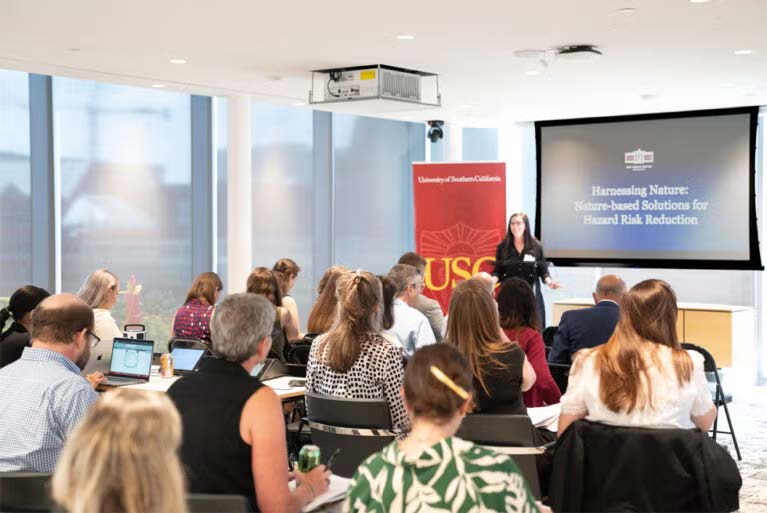Climate & Sustainability
Nature-Based Solutions:
Evidence for Hazard Risk Reduction and Ecosystem Services
The Problem
As the effects of climate change intensify, cities worldwide are increasingly investing in infrastructure projects to safeguard their communities from escalating risks, such as wildfires, air pollution, heat waves, coastal erosion, flooding, and drought. Infrastructure projects often rely on engineered designs and components, such as the cement walls lining the L.A. River, to reduce the risk of these hazards.
However, a new focus on integrating built and natural infrastructure promises better environmental, social, and economic outcomes. While nature-based solutions can be cost-effective in reducing hazards such as coastal flooding or urban heat islands, they face challenges. For example, studies show that living shorelines can reduce coastal erosion more effectively than conventional gray infrastructure methods like seawalls and provide additional benefits (such as habitat and recreational opportunities), but there is no standard manual for constructing living shorelines. The approach might depend on local ecology, wave energy, and erosion rates. They can also be more complicated to fund and permit than traditional engineered structures made of concrete and steel.
The Collaboration
 Public Exchange worked with the White House Office of Science and Technology Policy (OSTP) to host a day-long workshop, “Harnessing Nature: Using Nature-Based Solutions for Disaster Risk Reduction.” The meeting convened leaders in nature-based solutions to compare and integrate academic and practitioner perspectives, establish a shared understanding of the evidence base for nature-based approaches, and explore strategies to clear roadblocks and advance projects on the ground.
Public Exchange worked with the White House Office of Science and Technology Policy (OSTP) to host a day-long workshop, “Harnessing Nature: Using Nature-Based Solutions for Disaster Risk Reduction.” The meeting convened leaders in nature-based solutions to compare and integrate academic and practitioner perspectives, establish a shared understanding of the evidence base for nature-based approaches, and explore strategies to clear roadblocks and advance projects on the ground.
“Collaboration between government institutions, civil society, academia, and the private sector is key to harnessing the power of our built and natural environment to reduce hazards.” – Doug Mason, Assistant Director for Nature-based Solutions, White House Office of Science and Technology Policy (OSTP)
The Impact
In the six months since the workshop, the OSTP and the Science and Technology Policy Institute (STPI) issued a report that integrates the perspectives shared during the workshop to scale up nature-based solutions and accelerate research, innovation, and learning. The report evaluates the effectiveness of 23 nature-based solutions–to address hazards and bolster the health of ecosystems–such as increasing tree canopies in urban areas to combat heat, constructing wetlands to mitigate the impact of flooding, and restoring oyster reefs in coastal regions to improve water quality, among others.
The Report
Read the full report HERE to learn how nature-based solutions could revolutionize our efforts to shape a more climate-resilient future.
Collaboration Team Members
The Science and Technology Policy Institute (STPI) produced the above research. For questions regarding research findings, please contact IDA.

